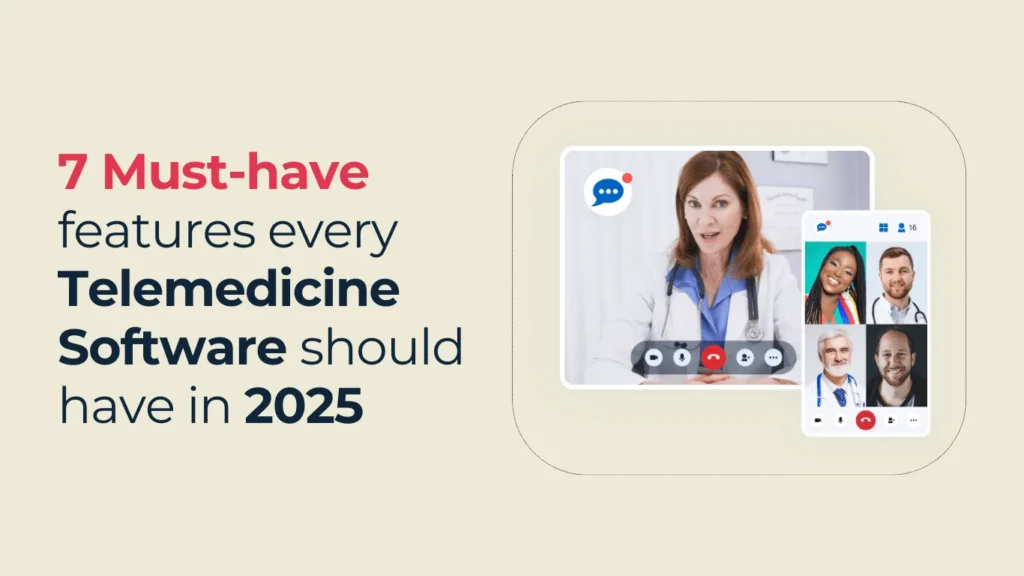The telemedicine sector has expanded quickly in the last several years. The reason is both a global shift toward remote healthcare and technical improvements. Healthcare Professionals will have more expectations with Telemedicine software features in the future. In a similar manner, patients and healthcare professionals are searching for complete, safe, user-friendly, and efficient systems.
Therefore, knowing what characteristics can set a telemedicine software development apart from others becomes crucial. The best qualities that any telemedicine program should have will be discussed in this post. Instead, developers can create superior solutions by concentrating on these aspects. At last, this will satisfy the evolving demands of the healthcare sector.
7 Key Telemedicine Software Features in 2025
Check out the following essentials features of a telemedicine platform:
User-Friendly Interface
User-friendliness must be the top priority for a successful telemedicine software. This feature improves user experience. It ensures that individuals of all ages and technological skill levels can easily use telemedicine services. The interface should have easy-to-use menus and services that are readily available. It can make payments, schedule appointments, and use virtual consultation tools.
Medical practitioners should find it easy to access patient information, medical records, and diagnostic tools through the platform. This ensures that they may focus on offering top-notch care without worrying about being constrained by complicated software. A simple, unambiguous interface encourages user acceptance of the telemedicine platform, reducing the learning curve.
Secure and Compliant Data Handling
By looking at increasing data breaching, this is one of the most important Telemedicine software features in 2025. The privacy and data security of a telemedicine software should not be compromised. Patients trust healthcare professionals with sensitive personal information, and the platform must be configured to handle this data properly. This compliance is essential for white-label telehealth solutions. It preserves confidence and credibility.
Regulations like the General Data Protection Regulation (GDPR) in Europe, the Health Insurance Portability and Accountability Act (HIPAA) in the US, and any other relevant local laws must be followed. Patient data should only be accessible by authorized individuals. The multi-factor authentication should be employed for added security.
High-Quality Video and Audio Capabilities
Telemedicine’s primary goal is to establish a virtual connection between patients and healthcare professionals. High-quality video conferencing is necessary for virtual doctor apps in order to support consultations and promote effective communication. Telemedicine software suppliers need, however, make their systems compatible with HD video and audio with extremely low latency, in contrast to earlier technologies. Real-time interaction is made possible by this. It is more accessible due to its compatibility with cellphones, tablets, and PCs. This makes the platform one of the top telehealth applications.
Telemedicine technologies are primarily used to facilitate remote consultations between patients and healthcare providers. For this, the platform must have excellent audio and video capabilities. Additionally, video conferencing systems must include features like screen sharing allow. It allows medical professionals to explain treatment plans, share test results, or disseminate educational materials.
Electronic Health Record (EHR) Integration
An efficient telemedicine software should be able to connect with existing Electronic Health Records (EHR) systems with ease. This integration provides physicians with access to a patient’s complete medical history, previous diagnoses, test results, and current treatment plans during a telemedicine session. Providers may provide more informed diagnoses and treatments ultimately improving patient outcomes.
All systems automatically maintain up-to-date patient records. We categorize this platform’s integration as a feature of cutting-edge telemedicine platforms. Telemedicine solutions should include real-time communication of medical documents, including prescriptions and test results. This feature reduces the need for follow-up appointments and in-person visits as everything can be done digitally.
Appointment Scheduling and Reminders
One of the key elements of any telemedicine software is an easier way to make appointments. Patients should have no trouble making, modifying, or canceling appointments with medical experts through the platform. Patients can choose from various time windows based on their availability.
Automated reminders by push alerts, SMS, or email can simplify scheduling. With advancements in artificial intelligence development, AI-powered scheduling systems can analyze patient preferences and doctor availability to optimize appointment booking. Having a robust reminder system is essential to ensuring a great experience for all parties involved. Reminding patients and healthcare providers of missed appointments can result in delays in patient care.
Multiple Communication Channels
Numerous channels of contact are provided by effective telemedicine software. They meet multiple patient needs and preferences. Video consultations are the primary feature for patients, while phone calls or text messages are occasionally preferred. It is important that patients can choose the communication method that best suits their requirements at any given time by offering numerous choices.
Text messaging can be quite useful for brief follow-up questions, prescription reminders, and sharing test results. Some patients may also choose audio conversations over video for simpler consultations or when video is unavailable due to limited internet connectivity. Telemedicine is more accessible and flexible when it has several communication channels. You should look out for this telemedicine software feature too in your software.
Health Tracking and Remote Monitoring
Remote patient monitoring (RPM) is a feature of telemedicine systems that is becoming more and more popular, particularly for the treatment of chronic conditions. RPM enables real-time monitoring of a patient’s vital indicators, such as heart rate, blood pressure, and glucose levels. This information is immediately sent to the healthcare physician via the telemedicine platform, allowing for timely action as necessary.
Patients recovering from surgery or those with chronic illnesses may find peace of mind with remote monitoring, which can also help doctors spot potential issues before they worsen.
Conclusion – Telemedicine Software Features
Telemedicine will continue to transform healthcare in 2025 and beyond by offering advanced technology that improves patient care, accessibility, and convenience. Any successful telemedicine software must have safe data processing, high-quality communication capabilities, and intuitive user interfaces. Features like prescription management, remote monitoring, and EHR integration further increase the platform’s effectiveness. For seamless data flow, security, and system scalability a well-structured backend is required, making it crucial to hire backend developers with expertise in healthcare solutions.
The way doctors treat patients might be drastically altered by investing in a powerful telemedicine infrastructure. This would also increase telemedicine’s efficacy and accessibility in the healthcare sector. To succeed in this new industry, certain key characteristics must be adopted.







